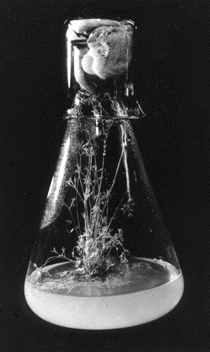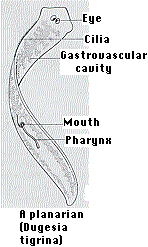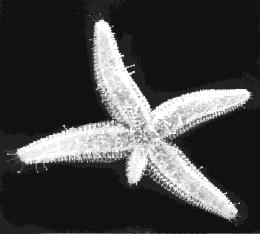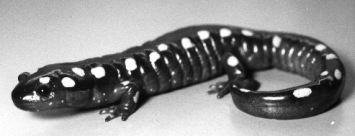Regeneration is the ability to replace lost or damaged body parts.
This ability varies greatly among living things.

Plants can regenerate all body parts from precursor cells. Many trees, for example, can be cut off at the ground and, in due course, sprouts appear at the margins of the stump. These go on to develop new stems, leaves, and flowers.
In the laboratory, entire plants can develop from a mass of undifferentiated cells growing in culture.
For example, a fully-differentiated carrot root cell when grown in a suitable culture medium, begins to divide repeatedly, losing its differentiated structure as it does so. Then its descendants begin to differentiate, and they finally form all the organs of a mature carrot plant.
The photo (courtesy of Roy De Carava and Scientific American) shows a carrot plant that grew in a flask from fully-differentiated root cells that had been isolated and induced to undergo mitosis.
This cnidarian can also regenerate its entire body from cells. The cells that do the job are totipotent stem cells residing in the animal's body.

These flatworms can regenerate the entire body from just a small piece. They do this by the proliferation and differentiation of the totipotent stem cells that it retains in its body throughout its life.
Planarians are valued for research on regeneration as individual genes that might participate in the process can be knocked out by RNA interference (RNAi).

These echinoderms can regenerate the entire organism from just one arm and the central disk.
I have read that at one time oyster fishermen used to dredge up starfish from their oyster beds, chop them up in the hope of killing them, and then dump the parts back overboard. They soon discovered to their sorrow the remarkable powers of regeneration of these animals.
The photo (courtesy of Dr. Charles Walcott) shows a starfish regenerating an arm.

These amphibians can regenerate a missing tail, legs, even eyes. This remarkable ability is particularly pronounced in the larval stage. For this reason, larval salamanders are favorites for doing research on regeneration.
For example, cutting the tail off a larval salamander initiates the following sequence of events:The answer appears to be both.
Don't we wish that we had the same powers of regeneration that salamanders do: able to regenerate a severed spinal cord or grow a new heart!
But unfortunately, we cannot. We can regenerate some skin and a large amount of liver. But that's about it.
Just why we are so limited is not known (but is the subject of intense research). Much of the excitement of research on stem cells is because of the hope that they may provide a means of regrowing damaged or lost tissues or even organs.
| Welcome&Next Search |